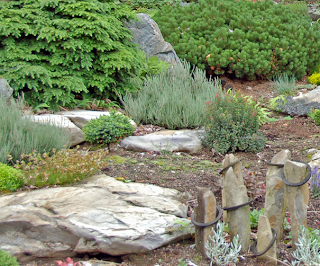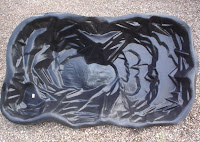A rock garden can add an
area of beautiful interest to your garden, transforming a plain garden into
something stunning in no time. You usually want a space that is at least 8-10
feet by 4-6 feet for it to be worthwhile.
There are some basic rules
with rockery stones though, first of all don’t steal stones from the
countryside, it’s illegal. Second, don’t use broken concrete or other
substituted stone as these will not be suitable. Try to use the same type of
stone for the whole rockery. For a 10 x 5 foot rockery you’ll need around 1-2
tons of stone, dependant on how dense you want the stone quantity to be.
Types Of Stone
Limestone – This stone
readily weathers, so the sharp edges are lost rapidly.
Lime hating plants may
suffer if you use limestone though. We would advise against using this type of stone around any ponds too, as this will turn your water alkaline.
The colour is usually grey, but this is not
always the case (Cotswold stone is a good example of a non-grey limestone).
Sandstone – There are plenty
of attractive colours available for example York Stone, although this does
split easy and is very hard.
Gloucester Red is a very nice looking brick
coloured stone.
Granite – A very hard and
fine-grained.
Granite is a non-porous stone and weathers very slowly, we’d
advise against using this for a rockery.
You will find granite is normally very expensive too.
Slate – This rock comes in
shades of grey, green or purple and is sharply cornered at first but will weather
over time in your garden.
Slate is a good choice for rockery if you can get
nice pieces.
First things first, plan carefully. This is essential before you begin your rockery,
remember that you want it to look as natural as you possibly can. You want to
pick an area which is free from shade for most of the day for it to thrive. We
also advise drawing a rough sketch too.
Next is to prepare the site. Pick a day when the soil is dry so it is easier to
work with. Make sure to remove all traces of weeds or these will come back to
haunt you and destroy your rock garden. Use a good weed killer if necessary
before you begin, glyphosate is a
brilliant product for killing weeds.
Drainage is
definitely recommended, Dig down around 1 foot and fill with a layer of broken
bricks and stones, rubble essentially, then add 2 inches of sand and then top
soil.
Move the stones into place. Please be careful at this point, we all know someone
with a bad back and we don’t want to be one of them do we? Remember, bend your
knees and keep your back straight, and don’t try to lift something you aren’t
strong enough to lift.
Set the stones into position. Place the stones in your desired spots, with around
one third to a half below the ground, make sure fracture lines run vertically,
not horizontally for a more natural look. Stand back after setting the stones
to view them and see if you like the appearance.
Planting time, use larger plants sparingly, and try to plant smaller varieties in
groups together. Try covering some, but not all of rock faces with carpeting
plants also. You can sprinkle gravel around in between your rockery stone.












